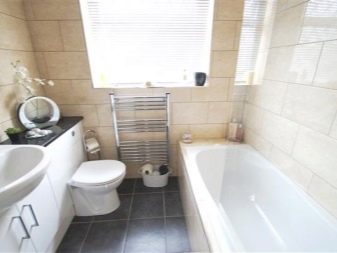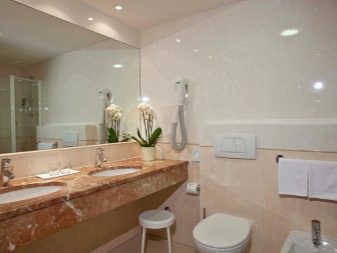Bathroom interior, combined with toilet
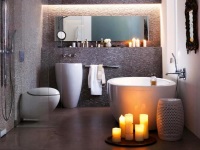
Combined bathroom - a phenomenon not uncommon. Some people like this option, some do not. In any case, it has its advantages and disadvantages. And how to create comfort and coziness in such a bathroom, and give it an original and beautiful design, we will tell in this article.
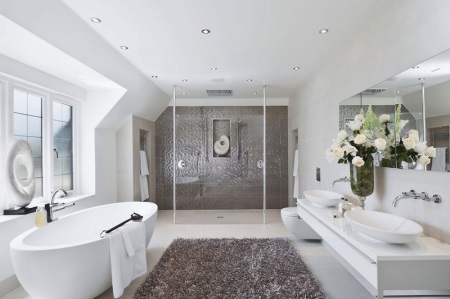
Pros and cons of combining
The pros of combining are that:
- The area of the room will increase due to the demolition of the wall between the restroom and bathroom.
- The layout of the combined bathroom requires less cost for the purchase of construction and finishing materials.
The main disadvantage of a combined bathroom is that it can not be used by two people at the same time. This is a problem especially for large families. For example, when in the morning hours, all family members need to take water procedures, use the toilet, apply makeup, etc.
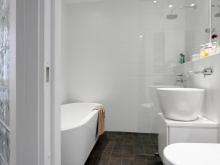
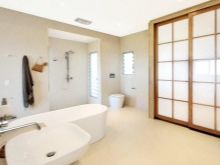
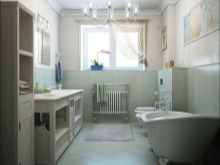
Requirements for interior elements
Having decided to combine the bathroom and restroom, first familiarize yourself with the requirements that apply to the room itself and to interior elements:
- Compactness of all plumbing fixtures, appliances and furniture.
- Moisture resistance of all products and materials used in finishing.
- Durability and practicality of all items.
- Availability of a window or other ventilation system.
- Combinability of materials, colors and shapes.
- Sufficient lighting.
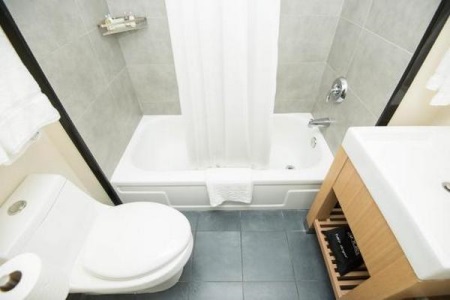
Planning
Any bathroom, first of all, is evaluated by its functionality. The more spacious the room and at the same time the more necessary for any bathroom fixtures, appliances and furniture, the higher the functionality of the room. Therefore, proper and preliminary planning is especially necessary for this room. In this part of the article, we will consider how you can place the bathtub, sink, toilet, washing machine, laundry basket and other bathroom accessories, so that the room does not become too cramped and it could be freely and comfortably used.
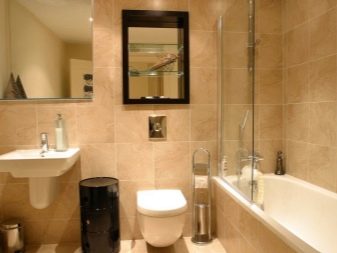
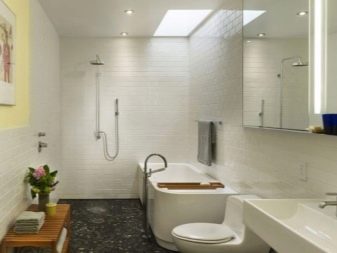
Principles of selection and placement of a standard set of elements of the interior of a combined bathroom are presented here:
Bathtub or shower cabin
If the area of the room is small, then instead of an oversized bath, it is desirable to mount a shower cabin in it. It will take up less space, but will perfectly cope with its function. Especially relevant for such premises corner types of showers. If you do decide to install a bathtub, you can place it against the wall in front of the entrance, and the other elements are mounted on one side. In this case, the need to dilute communications in different directions disappears. In addition, there are models of corner baths, which to some extent save space and make the room ergonomic.
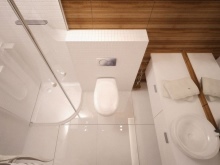
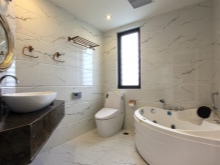
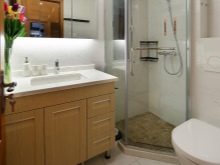
Sink
For small rooms, the installation of corner types of sinks, including sinks with pedestals, is considered the most optimal. In order to save space under the sink and add lightness and a modern look to the interior, look for suspended models of sinks and pedestals.
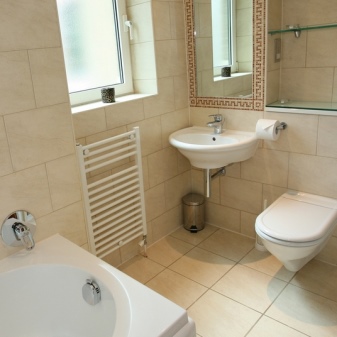
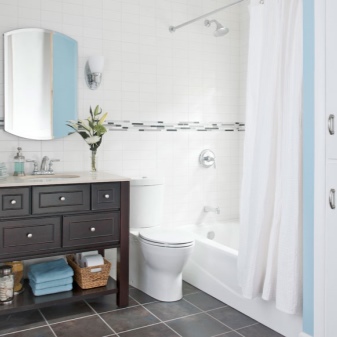
Toilet
The toilet is better to match the bath and the overall style of the interior of the room.
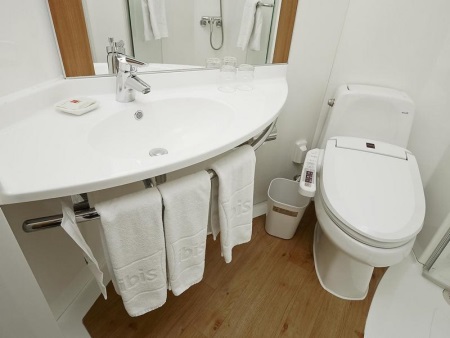
Washing machine
The washing machine can be installed either under the sink, or separately from all the furniture and fixtures. Owners of more spacious bathrooms can afford roomy tables with a sink and with a countertop under the washing machine.
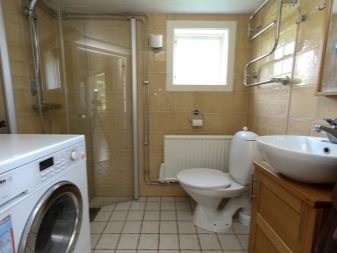
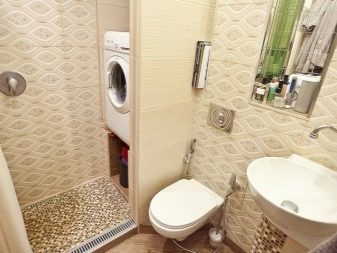
Furniture
In the bathroom, combined with the toilet, you can install various kinds of tables, cabinets and shelves. In them you will be able to place numerous cosmetics, bath accessories, towels, household chemicals, toilet paper, etc.
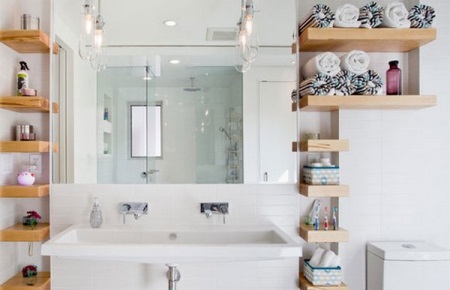
For proper planning in the beginning of all the work, draw a plan of the room and mark on it the location of water and sewage pipes. You will need this in order to avoid unnecessary laying of pipes. Place the plumbing fixtures in such a way that they can be connected to the utilities without any problems and at the same time so that the devices themselves are freely accessible. A very good technique for compact placement is to place all the plumbing fixtures against one wall, which allows you not to hinder movement in a relatively small area of the room. In addition, do not forget to provide on the plan the places of power supply lines for outlets, lighting and other electrical appliances.
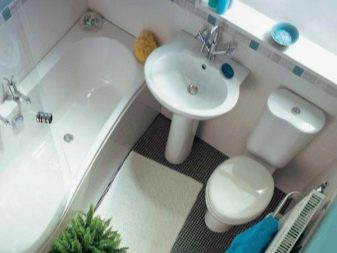
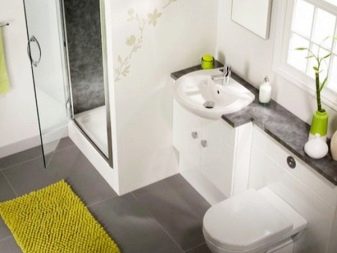
Below are the main recommendations of experienced designers to help make the bathroom as functional and comfortable as possible:
- The space in front of the shower or bathtub should not be less than 70 cm. It is desirable that this figure reached 110 cm.
- The same amount of space should be between the heating system and the bath or shower cabin.
- It is better to install the sink at a height of at least 80 cm from the floor.
- It is recommended to install the toilet bowl in a convenient location, providing free space around it - not less than 60 cm in front of the toilet bowl and 40 cm on its sides.
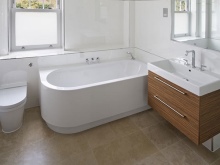
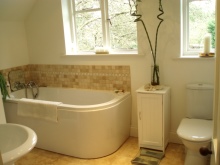

Popular materials for finishing
The most popular material for finishing the interior of the combined bathroom, is ceramic tiles.
Here are some tips on finishing the room with tiles:
- If you want to finish the walls of the bathroom with tiles, then we advise you to refer to already ready-made sets of wall and floor tiles from the manufacturer. That way you won't need to separately select tiles for the floor, wall and ceiling.
- For the same room, you can use different sizes or shapes of tiles of the same color. For example, small and medium sized tiles for the walls, and large sized tiles for the floor.
- Rectangular tiles arranged horizontally can visually increase the size of the room.
- To create an original, interesting and lively interior, use tiles of different colors to finish the walls and floor.
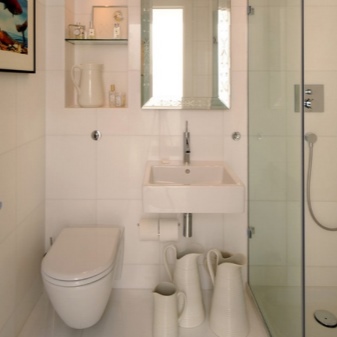
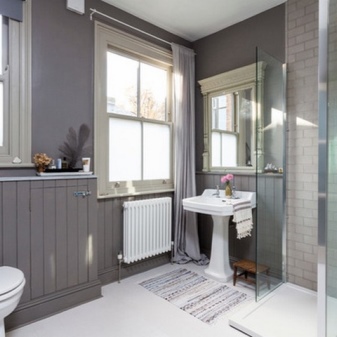
It is worth noting that in addition to tiles, porcelain tiles and mosaics are also used for finishing bathrooms. They are also characterized by high moisture resistance, strength and durability.

What room color scheme to choose?
In what color to decorate your bathroom depends entirely on your taste. The only thing to consider are the characteristics and features of some colors that should not be neglected.
For example:
Light colors can visually increase the area of the room.
Excessively bright and provocative colors sometimes have a negative impact on a person's well-being and mood, so instead of them, it is much preferable to paint bathrooms in warm colors and dim shades of fresh colors.
Bright colors can be used only if they will not be too much, and they will be diluted with other colors. Multicolored interior will always keep a good mood.
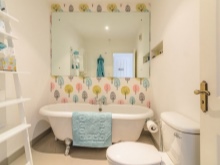
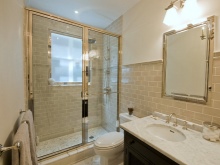
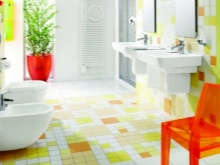
Black and other dark shades can also have a place in the bathroom, but they must necessarily be diluted with kippy white or warm dim colors, so as not to get too gloomy interior.
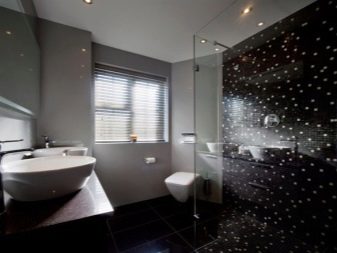
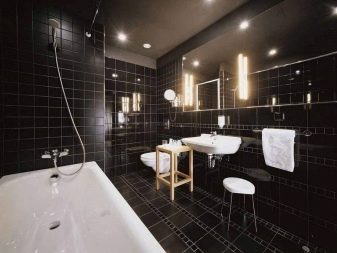
A very cheerful and positive interior will turn out with yellow. This color is good for limited space bathrooms, particularly if they have no windows;
Brown wood color in the interior of the bathroom is the color of elegant luxury. This color will be especially relevant if the furniture is made of natural wood, treated with moisture-resistant agents.
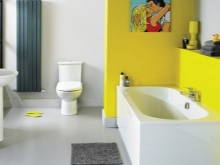
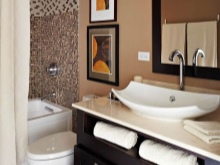
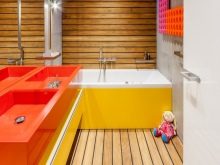
The feeling of a spacious room can also create a matte and transparent interior elements. For example, a transparent bath divider or shower enclosure door can to some extent neutralize the feeling of cumbersome plumbing.
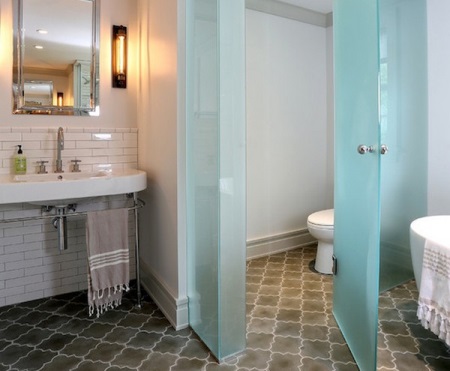
Zoning
Zoning of the combined bathroom is necessary in order to visually divide the area of the bath and toilet. This can be done in several ways:
- Architectural zoning.
- Color zoning.
- Light zoning.

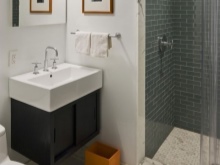

Architectural zoning.
This is done by means of partitions, screens and different niches. The partitions are made of plasterboard and are surfaced with a humidity-resistant varnish. It can also be painted with a decorative element. Task of the walls is not a real delimitation of bathroom, otherwise will lose all meaning of combined bathroom. They are designed to visually separate the bathroom and toilet areas.
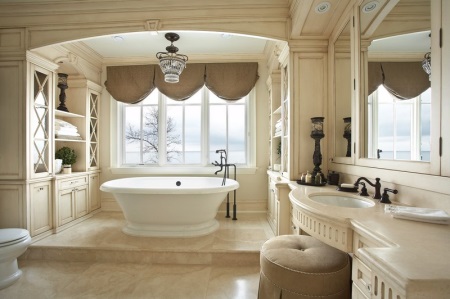
You can also delimit the zones with furniture, mats and houseplants. A long path, for example, can be paved at the edge of the bathtub and toilet. In a spacious bathroom, zoning can be done with potted floor plants, for example, put them between the toilet and washbasin. Zoning a bathroom with a large area can also be done by different levels of the floor and ceiling.
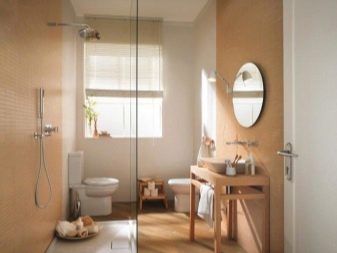
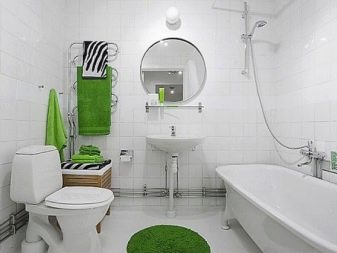
Light zoning
Delimitation of different in brightness and shades of light streams is carried out with the help of different fixtures, lamps and other lighting devices. For example, the lamps installed above the sink will direct a stream of bright light to it. The zoning effect will be created by the fact that the sink area will be brightly lit and the toilet and bath areas will be darkened.
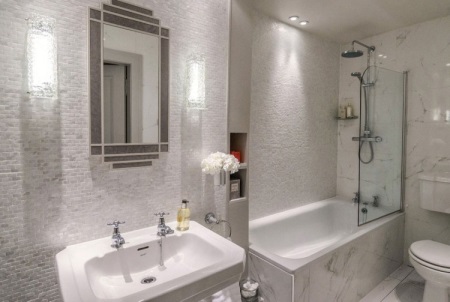
Color zoning
This method is considered the most economical and convenient way of delimitation. Because by means of colors you can both zone and colorfully decorate the interior of the room at the same time.
The possibilities for zoning the space with colors are endless:
- You can make accents on the main elements of the interior. For example, if the room is finished with red tiles, the bathroom fixtures and furniture can be bought in white. On a red background, they will immediately stand out. And to enhance the accents and the precise distribution of zones, the surface around the mirrors and towel rails can be finished with white tiles.
- An interesting interior will turn out if you paint the bathroom and toilet area in different colors.
- Zoning can also be carried out using tiles with decorative elements.
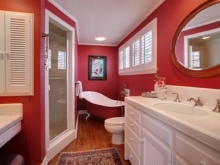
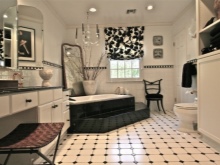
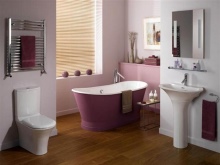
Ventilation
A combined bathroom is a place in two with a high level of humidity. Therefore, regardless of its size, it must be provided with a good ventilation system.
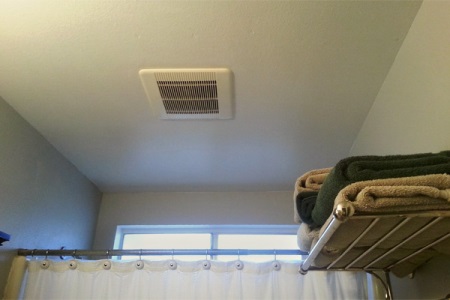
Lighting
In the bathroom there is never much light: a brightly lit room in the morning will easily wake up your body, cheer you up and lift your spirits and help you to apply makeup perfectly. In addition, bright lighting can visually expand the space. In such a room, you should obligatory install two types of lighting - general and local. It is also desirable to install a relay switch, which allows you to adjust the brightness of light. General lighting is usually installed on the ceiling. And the installation of local lighting depends, above all, on your wishes and taste. Usually they are installed near the mirror or bathtub. So in the evening after a hard day's work, leaving a dimmed light near the bath, you will be able to relax and even meditate. Halogen lamps can also be installed in furniture and on the ceiling.
It is important to remember that all lighting fixtures used in the bathroom, should be designed for high levels of humidity.
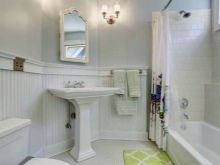

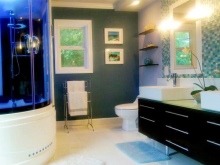
How to "enliven" the interior: a little about accessories
After the repair and installation of all the plumbing and furniture, there comes a stage, probably for many the most pleasant and easy - the stage of "reviving" the interior. "Revitalize" the interior can be done with the help of:
- indoor plants;
- textile products: rugs, towels etc.;
- pictures in glass frames;
- soap dishes, toilet paper holders, dispensers;
- laundry baskets, etc.
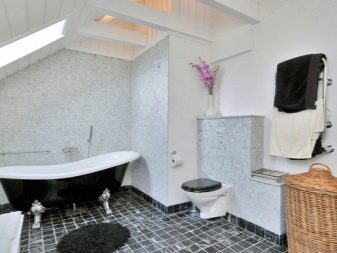
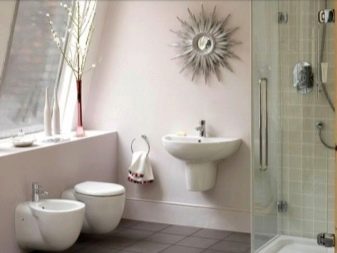
Towel racks can be mounted on the wall directly above the tub or washing machine, as well as on the inside of the door. Also, don't forget about mirrors. Large mirrors contribute to the visual enlargement of space. Such a mirror can be on the wall above the sink. Mirrors can also be placed in wall niches, acting as a shelf. It is not recommended to create a mirror ceiling in small bathrooms, as this can create a well effect.
